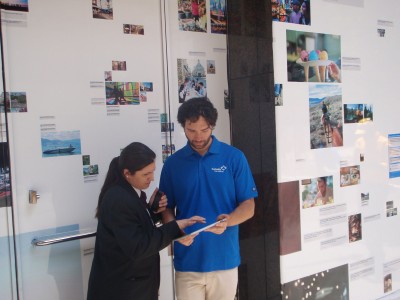
In 2010, a campaign promoting Canadian tourism made heavy use of Twitter and YouTube to bring photos, videos and other user-generated content to storefront digital signage. Photos courtesy DDB Canada
Feedback showed the most common interactions with the screens were a minute or less, but 16 viewers interacted with them for much longer, between 30 minutes and two hours. And the majority of viewers interacted more than once, including nine patrons who each sent multiple texts to the screens within a 15-minute period. The heaviest period of interaction was around 11 p.m.
That same year, MegaPhone Labs developed an interactive mobile campaign for Adidas at the National Basketball Association (NBA) All-Star Game in New Orleans, La. The ‘guerrilla’ campaign used a branded van, outfitted with a 3-m (10-ft) screen and parked at a street corner near the game.
“It essentially combined OOH, casual games, mobile marketing and location-based services,” says Dan Albritton, co-founder and CEO of MegaPhone. “It was designed to encourage engagement with the brand through interactivity and add names to the Adidas mailing list. Participants received location-based SMS notifications of special events and promotions at their nearest Adidas stores.”
The interactive campaign generated three times as many opt-ins as all other promotional methods combined, including radio, TV, billboards and print.
“And they opted out only half as much compared to all other paths,” says Albritton. “Ultimately, the campaign was vastly superior in terms of cost and response rate.”
Game on!
As mentioned, games have proven a particularly effective way to raise brand awareness. In the past, for example, LocaModa has also partnered with Clear Channel Spectacolor, which operates a 12.2 x 12.2-m (40 x 40-ft) digital screen in Times Square in New York, N.Y., to launch a series of interactive games for passersby.
Their first joint application was Jumbli, a word game based on text messaging and also playable from a dedicated website. Standing in Times Square, players submitting the highest-scoring words from their mobile phones could then see their names appear on the screen, along with online players’ winning entries. The game ran four to five times each day, with ads appearing on a lower portion of the screen.
LocaModa also developed an interactive game for the same billboard on behalf of Harrah’s Entertainment. In this case, the application took the form of a mobile-controlled virtual slot machine.
“Very simple games with clear instructions and a user-friendly interface tend to perform best in public places,” says Jayne Karolow, LocaModa’s director of community. “Users in the OOH environment must be able to enter a game at any time and immediately understand how it works or they’ll simply move on.”





